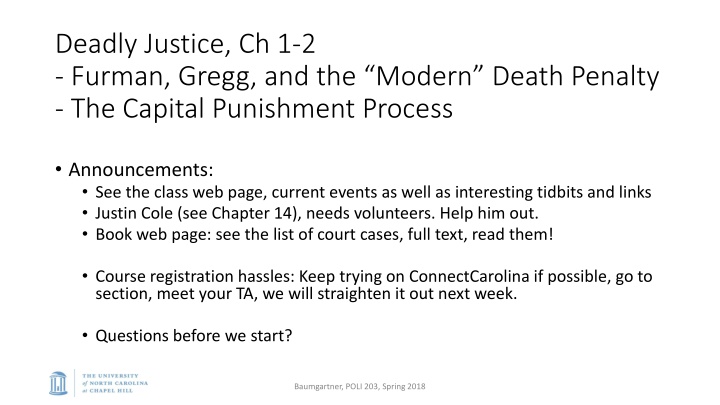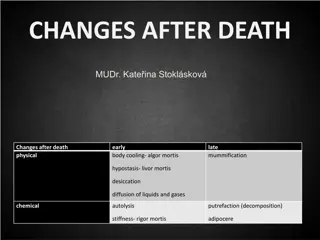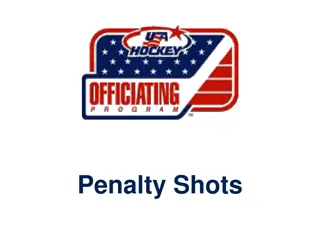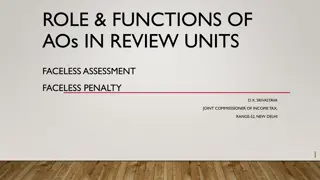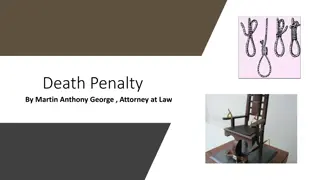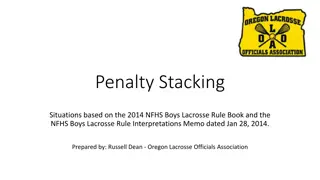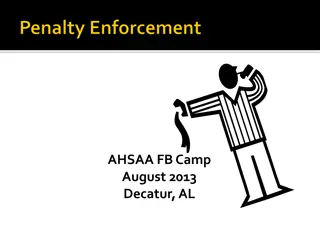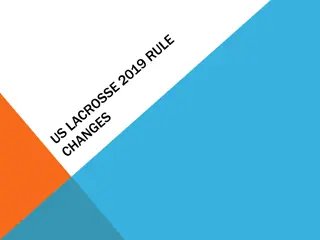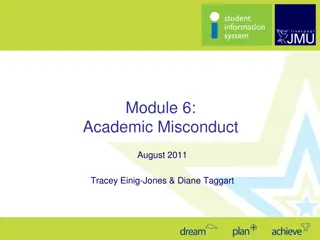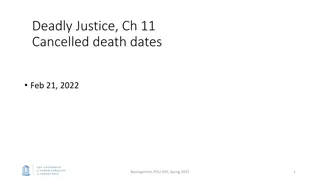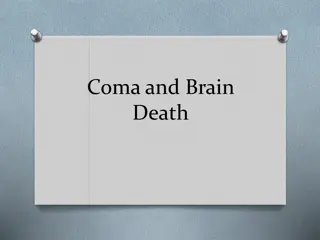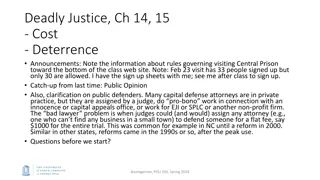Evolution of the Death Penalty in the United States
The history of capital punishment in the US, from its early roots in the 17th and 18th centuries to the current constitutional debates surrounding it. The chapters explore landmark court cases and legal interpretations, tracing the evolution of the death penalty and its constitutional implications. Discussions include original intent legal theories, evolving standards of decency, and specific constitutional amendments such as the 5th, 8th, and 14th Amendments.
Download Presentation

Please find below an Image/Link to download the presentation.
The content on the website is provided AS IS for your information and personal use only. It may not be sold, licensed, or shared on other websites without obtaining consent from the author.If you encounter any issues during the download, it is possible that the publisher has removed the file from their server.
You are allowed to download the files provided on this website for personal or commercial use, subject to the condition that they are used lawfully. All files are the property of their respective owners.
The content on the website is provided AS IS for your information and personal use only. It may not be sold, licensed, or shared on other websites without obtaining consent from the author.
E N D
Presentation Transcript
Deadly Justice, Ch 1-2 - Furman, Gregg, and the Modern Death Penalty - The Capital Punishment Process Announcements: See the class web page, current events as well as interesting tidbits and links Justin Cole (see Chapter 14), needs volunteers. Help him out. Book web page: see the list of court cases, full text, read them! Course registration hassles: Keep trying on ConnectCarolina if possible, go to section, meet your TA, we will straighten it out next week. Questions before we start? Baumgartner, POLI 203, Spring 2018
Furman, Gregg, and the Creation of the Modern Death Penalty Long history of executions in the US, since 1608 Framers clearly envisioned the death penalty Death penalty in early period for horse stealing, adultery, lots of crimes. No penitentiaries in the 17th, 18th c. Punishments: stockade, whipping, banishment, shaming, death Baumgartner, POLI 203, Spring 2018
Executions reach a peak in 1935: 198. Note the decline from then through 1965 Baumgartner, POLI 203, Spring 2018
Constitutional issues The constitution explicitly refers to capital punishments, so therefore we can assume that the founders understood we would have capital punishment and that they were comfortable with that. Current original intent legal theorists point this out commonly. On the other hand, the court has made arguments about evolving standards of decency and there are other elements in the constitution that appear to rule out capital punishment in some circumstances. Baumgartner, POLI 203, Spring 2018
5th Amendment No person shall be held to answer for a capital, or otherwise infamous crime, unless on a presentment or indictment of a Grand Jury, except in cases arising in the land or naval forces, or in the Militia, when in actual service in time of War or public danger; nor shall any person be subject for the same offense to be twice put in jeopardy of life or limb; nor shall be compelled in any criminal case to be a witness against himself, nor be deprived of life, liberty, or property, without due process of law; nor shall private property be taken for public use, without just compensation. Baumgartner, POLI 203, Spring 2018
8th and 14th Amendments #8: Excessive bail shall not be required, nor excessive fines imposed, nor cruel and unusual punishments inflicted. #14: All persons born or naturalized in the United States, and subject to the jurisdiction thereof, are citizens of the United States and of the State wherein they reside. No State shall make or enforce any law which shall abridge the privileges or immunities of citizens of the United States; nor shall any State deprive any person of life, liberty, or property, without due process of law; nor deny to any person within its jurisdiction the equal protection of the laws. Baumgartner, POLI 203, Spring 2018
The Framers Clearly Envisaged Capital Punishment Common punishments in 1790: Slice off parts of the ear, cut off a hand Boil in oil Stockade, blocks, 50 lashes We don t allow those punishments anymore. But with the constitution explicitly referring to capital punishment, this is a hard sell. The justices argued explicitly about this in 1972. No doubt about original intent Baumgartner, POLI 203, Spring 2018
Furman v. Georgia, 1972 Actually several cases: Furman v. Georgia Jackson v. Georgia Branch v. Texas Aikens v. California (This was a very bad case a very horrific set of facts but was rendered moot just before the USSC ruled, as the California SC ruled the state s death penalty unconstitutional under the state constitution s ban on cruel OR unusual punishments; see People v. Anderson (1972). So, while arguments were heard on this in Jan 1972, by the time the USSC ruled on June 29, 1972, Aikens was no longer on death row.) California s death row was large, included Sirhan Sirhan, Charles Manson, others. Baumgartner, POLI 203, Spring 2018
Furman v. Georgia Furman, a black man, was convicted of killing a white homeowner during a burglary. He said it was unintentional, shooting his gun while he tripped, attempting to flee. But he homeowner died. The jury had complete discretion to impose death or not, and it sentenced him to death. After all it was felony murder . Multiple, different, opinions by each of the justices, none with more than 3 agreeing to sign. 5-4 decision nonetheless invalidates every existing law, empties the nation s death rows (700 inmates spared). Only two justices say the death penalty is, in all circumstances, unconstitutional Baumgartner, POLI 203, Spring 2018
Wonton and freakish, like being struck by lightning (among convicted murderers) One justice s opinion focuses on the capricious and arbitrary nature of the punishment Many of those given the death penalty are NOT guilty of the most heinous crimes. Concern about impact of race here, but no clear finding that race drives it. No Procedural safeguards to guarantee fairness Extreme rarity of the punishment: who gets selected, it is like being struck by lightning Note: One solution to this freakishness would be to make the death penalty mandatory. North Carolina did this, in fact, in response to the ruling. Baumgartner, POLI 203, Spring 2018
Deterrence Is it acceptable to punish on person more severely just to make an example ? Does that mean that we are treating a human life as an object, merely a means to an end? Is it constitutionally acceptable to treat a person as an object, or is that inhumane? Given the low rate of usage of capital punishment, is there any deterrent value, anyway? Note that the first two concerns apply even if there is a deterrent value. Baumgartner, POLI 203, Spring 2018
As many decisions / opinions as justices, almost. Inherently unconstitutional under all circumstances: Brennan and Marshall Capricious and arbitrary: Brennan, Stewart, White, Marshall, Douglass No deterrent effect: White, Marshall, Brennan A 4 part test: Brennan (A punishment does not comport with human dignity if it is: Unusually severe Inflicted arbitrarily Substantially rejected by contemporary society No more effective than a less severe punishment) (We will come back to this idea of penological value later in the term) Evolving standards of decency: several justices The dissenters: Poppycock! Original intent, popular sentiment, deterrence, legislative rights, state s rights (Burger, Blackmun, Powell, Rendquist) Baumgartner, POLI 203, Spring 2018
Five Justices, Five Reasonings Brennan Stewart White Marshall Douglas X X X X X Capricious X X X Racially Biased X X No Deterrent Value X X X X Cruel / inhumane X X X Retributive only Would eliminate capital punishment in the abstract X X Baumgartner, POLI 203, Spring 2018
Four dissenters, including the Chief Justice (Warren Burger) Elected officials have passed these laws, this is clear judicial over- reach 14thamendment clearly mentions deprive of life so the constitution assumes that capital punishment is possible. (5th amendment also refers to capital crimes) All four appointed by Pres. Nixon Clearly foreshadow the original intent argument that the constitution does not evolve Burger s dissent provides road-map for acceptable laws in the future: narrow targeting, proportionality guarantees Baumgartner, POLI 203, Spring 2018
Compare Furman to Brown v. Board Often, people say that the Court will try to have a unanimous decision when it knows the decision will test its legitimacy Brown v. Board, 1954, very controversial, but united, unanimous Furman v. Georgia, 1972, pretty much the opposite Emptied all US death rows, but with no single compelling logic. And the response was furious, especially from the South (and the right) Baumgartner, POLI 203, Spring 2018
The response, wow was that fast! Baumgartner, POLI 203, Spring 2018
Gregg v. Georgia, 1976 Also a combination of 4 cases: Gregg v. Georgia Profitt v. Florida Jurek v. Texas Roberts v. Louisiana Woodson v. North Carolina First 3 affirmed, last two shot down (mandatory death for all eligible) Baumgartner, POLI 203, Spring 2018
Fixing the flaws of Furman Narrow Targeting Specify only the most heinous crimes Substantial proportion Don t just pick out a few; that allows too much room for bias and caprice Aggravators weighed against mitigators Most awful crimes, most deserving criminals, both Two stage trial: Guilt, then punishment, separately (with same jury) Proportionality (state Supreme Court review and approval needed) Make the punishment fit the crime, only use it for the most deserving Baumgartner, POLI 203, Spring 2018
But, wait, Jurek v. Texas was also affirmed Texas had a different system than Georgia and Florida Limited crimes But instead of aggravators and mitigators, Texas asked the jury to contemplate future dangerousness and to sentence to death if they found it. So, clearly, the Court was willing to take a number of approaches, and approve them. Texas argued that discussing future dangerousness allowed jurors to consider mitigators. Only NC and Louisiana s mandatory schemes were ruled out. Baumgartner, POLI 203, Spring 2018
McGautha v. California (1971), and the line between life and death The Court never said that there was a clear line between when a jury or a judge should rule for death or rule for life: Drawing that line, and expressing it in writing, appear to be tasks which are beyond present human ability the factors which determine [life or death] are too complex to be expressed within the limits of a simple formula So, no list of mitigating factors. No clear instructions to juries or judges are possible. I m not kidding. There really is no judicial standard. Baumgartner, POLI 203, Spring 2018
OK, the big puzzle we will discuss In Furman, they say it s arbritrary, flawed, no useful purpose. In Gregg they say it has not been limited to only the most serious crimes, and only for the most deserving criminals Now, after 2015, that made 40 years from 1976, and 1,422 executions. The goal of the book is to assess whether we meet the promise of Gregg, or flunk the test laid out in Furman. Baumgartner, POLI 203, Spring 2018
Ch. 2: The Process (and vocabulary) Pre-trial detention. (Most capital defendants are not given bail. So just being charged with a capital crime means you may go right to jail as you await trial, maybe 1-2 years) Notice of Intent (to seek death) Appointment of Counsel (revised over time) Plea bargaining (you are in jail, they are seeking death, many take a plea. This is true in general throughout the CJ system: over 80 percent of all charges end in a plea) Death qualification Baumgartner, POLI 203, Spring 2018
Lets do that last one again to make sure Death qualification You can t serve on a capital jury if you don t support the death penalty Even the guilt phase of the trial has a death-qualified jury Lots of litigation about this issue, end result is you can have qualms, hesitance, take it seriously, but if you say you could never vote for death, you cannot be on the jury Baumgartner, POLI 203, Spring 2018
Process (cont) Jury selection Qualification Peremptory challenges for both sides (12 in NC) ( jury bleaching get rid of minorities; Batson v. Kentucky) Trial of guilt, trial of punishment (punishment phase) Direct appeals: State SC must review the case compared to other cases to ensure equity ( proportionality review ) Federal courts must review as well No one can be executed post 1976 without federal court approval Post-conviction appeal Not automatic, but petition for cause, in state court, as well as federal court (Habeas corpus); these can go on as in any other proceeding. Baumgartner, POLI 203, Spring 2018
Process (cont) Death warrant: Governor (or attorney general) sets a date for the execution Stay: it s delayed for more appeals Clemency: Governor reduces the sentence to life Exoneration: one or another of the appeals is successful, and you are not re-tried; you go free! (about 160 people have been exonerated) Pardon: you re still guilty, but sentence eliminated (never done for capital crimes). Pardon of innocence: you ve been found innocent or have been exonerated, and the governor issues you this as an affirmative finding of your innocence, otherwise impossible in the judicial system. Official / prosecutorial immunity: very hard to hold a judge, DA, or other accountable. Waiving the right to appeal: Suicide by government (see Dylan Roof); about 10 percent of all executions have been volunteers) Baumgartner, POLI 203, Spring 2018
Death Is Different The Court has ruled that the new death penalty had to have special safeguards, not available where the penalty is not death Result: a massive mess, huge delays, 70 percent of cases overturned, huge costs, more rights to the defense, and very few executions get carried out. Danger / risk of executing an innocent, which no one wants. So efforts to streamline have not been successful, even when tried. So, as we evaluate, we have to evaluate the complicated, messy system we have, not the one we think we might like to have. Baumgartner, POLI 203, Spring 2018
